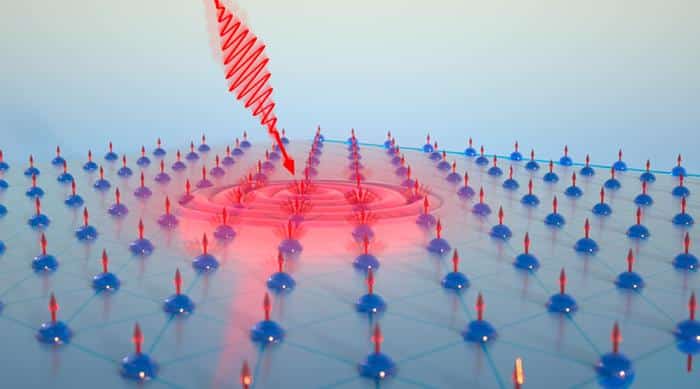Researchers at UChicago’s Pritzker School of Molecular Engineering have unveiled a game-changing optical memory material that promises faster, more efficient data storage, spotlighting the power of fundamental science.
In a stunning breakthrough, scientists at the University of Chicago’s Pritzker School of Molecular Engineering have developed a new material that promises to revolutionize data storage by leveraging light to control magnetic properties, enabling faster and more energy-efficient information processing.
The team, led by Assistant Professor Shuolong Yang, discovered that a complex material made from manganese, bismuth and tellurium (MnBi2Te4) exhibits unique magnetic properties when exposed to light. This means that a laser can be utilized to encode data within the magnetic states of MnBi2Te4, a concept that could dramatically improve the speed and efficiency of memory devices.

Credit: Pritzker School of Molecular Engineering, University of Chicago
“This really underscores how fundamental science can enable new ways of thinking about engineering applications very directly,” said Yang in a news release. “We started with the motivation to understand the molecular details of this material and ended up realizing it had previously undiscovered properties that make it very useful.”
The research, published in the journal Science Advances, demonstrates how electrons in MnBi2Te4 compete between two opposing states — a topological state, advantageous for quantum information encoding, and a light-sensitive state, beneficial for optical storage.
Solving a Topological Puzzle
MnBi2Te4 has long been studied for its potential as a magnetic topological insulator (MTI), a material that behaves as an insulator inside but permits electric current on its surfaces. In an ideal MTI, a phenomenon known as the quantum Hall effect occurs, where electric currents flow in a streamlined, two-dimensional path along the material’s edges — a concept essential for quantum data transmission.
However, experimentally leveraging MnBi2Te4’s topological properties has been challenging.
“Our initial goal was to understand why it has been so hard to get these topological properties in MnBi2Te4,” added Yang. “Why is the predicted physics not there?”
Using advanced spectroscopy techniques developed in Yang’s lab, and collaborating with the University of Florida’s Xiao-Xiao Zhang for magneto-optical Kerr effect (MOKE) measurements, the researchers could observe electron behaviors and their interaction with light in real time.
Discovering Two Opposing States
The study revealed that MnBi2Te4 hosts a quasi-2D electronic state that competes with the topological state for electrons, impeding its performance as a topological material. However, this quasi-2D state exhibited a strong link between magnetism and external photons, aligning perfectly with the needs of optical memory systems.
“There is a completely different type of surface electrons that replace the original topological surface electrons,” Yang added. “But it turns out that this quasi-2D state actually has a different, very useful property.”
Looking ahead, Yang’s group plans experiments to manipulate MnBi2Te4’s properties using lasers. They believe this material could significantly outperform current electronic memory devices in terms of efficiency.
Understanding the balance between the two electronic states might also enhance MnBi2Te4’s potential as an MTI, making it a dual-purpose material suitable for both quantum and optical data storage.
“Perhaps we could learn to tune the balance between the original, theoretically predicted state and this new quasi-2D electronic state,” Yang added. “This might be possible by controlling our synthesis conditions.”
With this groundbreaking discovery, the future of high-speed, energy-efficient data storage looks brighter than ever, cementing fundamental science’s critical role in pioneering new technological advancements.

